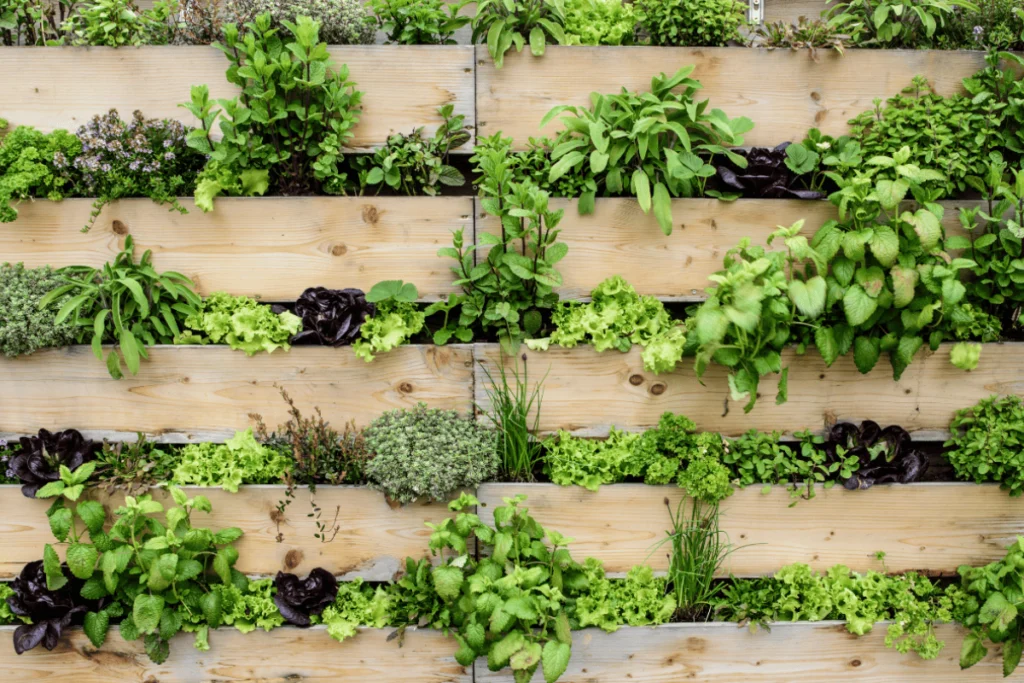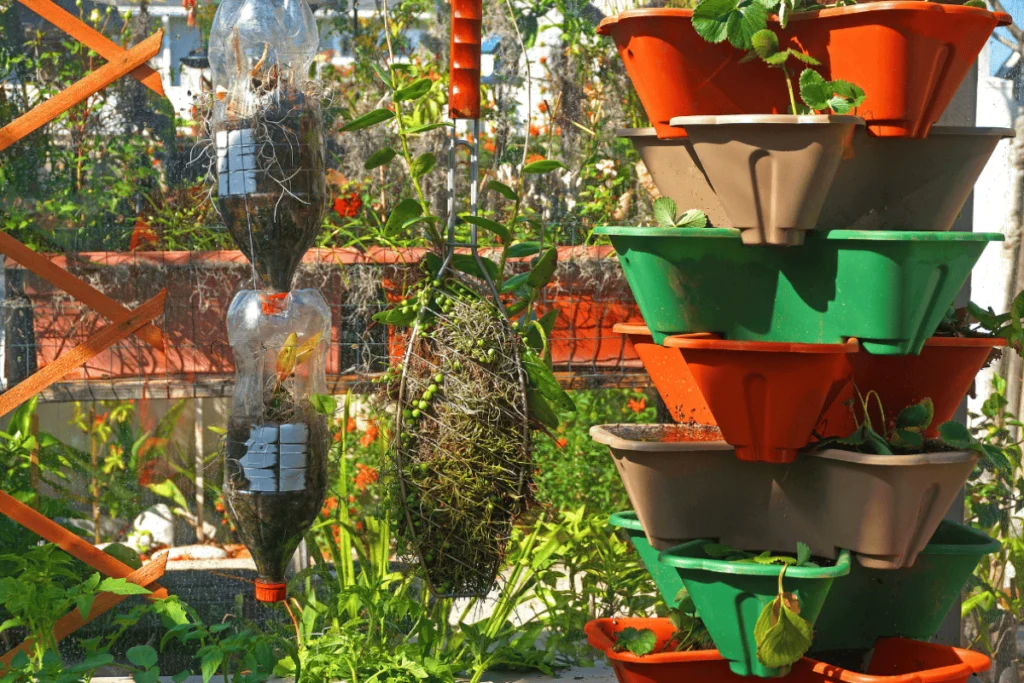A Greener Future Starts with Vertical Gardening
Vertical gardens and sustainability go hand in hand, offering a powerful solution for eco-friendly living and waste reduction.
More than just decorative additions to your home or outdoor space, vertical gardens transform small areas into lush, productive gardens while adopting practices that minimize environmental impact.
In this guide, we’ll explore how vertical gardens contribute to sustainability and provide actionable tips for reducing waste in your gardening efforts.
Why Are Vertical Gardens Sustainable?
Vertical gardens and sustainability are deeply connected, as they allow efficient use of space and resources while reducing environmental impact.
- Space Optimization:
Vertical gardening allows you to grow more in less space, making it ideal for urban environments where land is limited. - Resource Efficiency:
Vertical systems use water and soil more efficiently by delivering resources directly to the plants, minimizing waste. - Reduced Carbon Footprint:
Growing your own food locally eliminates the need for long-distance transportation, cutting greenhouse gas emissions. - Waste Reduction:
Many vertical garden designs incorporate recycled or upcycled materials, creating opportunities to repurpose items and minimize waste.
For a deeper understanding of how vertical gardens contribute to sustainability, check out this comprehensive guide by Singular Green here.
Tips to Reduce Waste in Vertical Gardens

1. Use recycled and repurposed materials.
These tips will help you combine vertical gardens and sustainability, creating a waste-free gardening system that benefits your space and the planet.
- Pallets: Use old wooden pallets as vertical garden frames.
- Plastic Bottles: Cut and convert bottles into planters for herbs or small plants.
- Tin Cans: Paint and repurpose cans to add a rustic touch to your garden.
- Wooden Crates: Stack crates to create tiered garden beds.
2. Install a Water Recycling System
Efficient watering techniques conserve water and reduce waste:
- Drip Irrigation: Provides targeted hydration, preventing excess runoff.
- Rainwater Collection: Install a barrel to capture rainwater for watering plants.
- Reservoirs: Use trays or containers to catch excess water and redirect it back to the plants.
3. Grow Edible Plants
Growing your own food minimizes waste and promotes sustainability:
- Vegetables and Herbs: Plant high-yield crops like lettuce, basil, spinach, and tomatoes.
- Fast-Growing Crops: Choose plants that mature quickly for frequent harvests.
- Crop Rotation: Switch up what you plant to maintain soil health and reduce waste.
4. Compost Organic Waste
Recycle organic waste into valuable nutrients for your garden:
- Kitchen Scraps: Compost vegetable peels, eggshells, and coffee grounds.
- Garden Clippings: Add leaves, grass, and plant trimmings to your compost.
- Compost Tea: Use compost steeped in water as a liquid fertilizer.
Want to turn kitchen scraps into nutrient-rich soil? Check out our step-by-step guide on How to Make Homemade Compost and start composting today!”
5. Opt for Durable Materials
Invest in long-lasting tools and structures:
- Use biodegradable pots or materials like terracotta and bamboo.
- Avoid single-use plastics and prioritize materials that can be reused for years.
6. Use Organic Fertilizers
Chemical fertilizers contribute to runoff and pollution—organic alternatives are safer:
- Use compost, bone meal, or fish emulsion as nutrient sources.
- Apply fertilizers sparingly to prevent waste and nutrient leaching.
7. Practice Smart Planting
Optimize your planting strategy to reduce waste:
- Cluster plants that share similar water and light requirements in the same area.
- Plant densely in vertical systems to maximize yields.
- Opt for perennials or self-seeding plants to reduce the need for replanting.
8. Implement Natural Pest Control
Minimize waste and chemical use with eco-friendly pest management:
- Companion Planting: Pair plants that deter pests naturally, like marigolds with tomatoes.
- Natural Repellents: Use neem oil, garlic spray, or diatomaceous earth.
- Attract Beneficial Insects: Encourage ladybugs and bees to keep pests in check.
This video offers a practical guide on creating a sustainable vertical garden, focusing on reducing waste through recycled materials
Benefits of Reducing Waste in Vertical Gardens
Reducing waste through vertical gardens and sustainability practices leads to healthier gardens, cost savings, and environmental benefits.
- Environmental Impact:
- Diverts materials from landfills by repurposing them in the garden.
- Reduces runoff and preserves nearby ecosystems.
- Cost Savings:
- Repurposing materials lowers gardening expenses.
- Growing your own food cuts down grocery bills.
- Healthier Gardens:
- Organic practices improve soil health and plant resilience.
- Eliminating chemicals creates a safer environment for pets and people.
- Community Inspiration:
- A sustainable garden can serve as a model for neighbors and friends.
- Educates others on how to integrate eco-friendly habits into their lives.
Creative Waste-Reducing Ideas for Vertical Gardens

- Vertical Bottle Garden: Convert used plastic bottles into hanging planters for herbs or small flowers.
- Pallet Herb Wall: Use an old wooden pallet to create a rustic vertical herb garden.
- Self-Watering Planters: Create a DIY self-watering system using jars and wicks.
- Eco-Friendly Decorations: Add reclaimed wood, stones, or driftwood for natural and sustainable decor.
- Upcycled Furniture Garden: Turn an old bookshelf or ladder into a unique tiered planter system.
Frequently Asked Questions (FAQ)
1. Can vertical gardens really reduce waste?
Yes! Vertical gardens encourage the reuse of materials, composting, and resource efficiency, all of which help minimize waste.
2. What materials are best for sustainable vertical gardening?
Recycled and durable materials like wooden pallets, metal frames, terracotta pots, and bamboo are excellent choices.
3. How does composting benefit a vertical garden?
Composting recycles organic waste into nutrient-rich soil, reducing the need for chemical fertilizers and promoting healthy plant growth.
4. Are vertical gardens suitable for growing food?
Absolutely! Vertical gardens are perfect for herbs, leafy greens, and even fruits like strawberries, as they require minimal space and thrive in vertical setups.
5. How can I conserve water in my vertical garden?
Use drip irrigation, rainwater collection systems, and self-watering planters to minimize water waste.
Conclusion: A Greener Garden, A Greener World
Vertical gardens are a powerful way to embrace sustainability and reduce waste, making them an ideal choice for eco-conscious gardeners. By repurposing materials, conserving resources, and growing your own food, you create a thriving, eco-friendly garden that benefits both your home and the planet.
Take the first step toward a sustainable future today start your vertical garden and inspire others to do the same. Together, we can cultivate a greener, cleaner, and more sustainable world!

